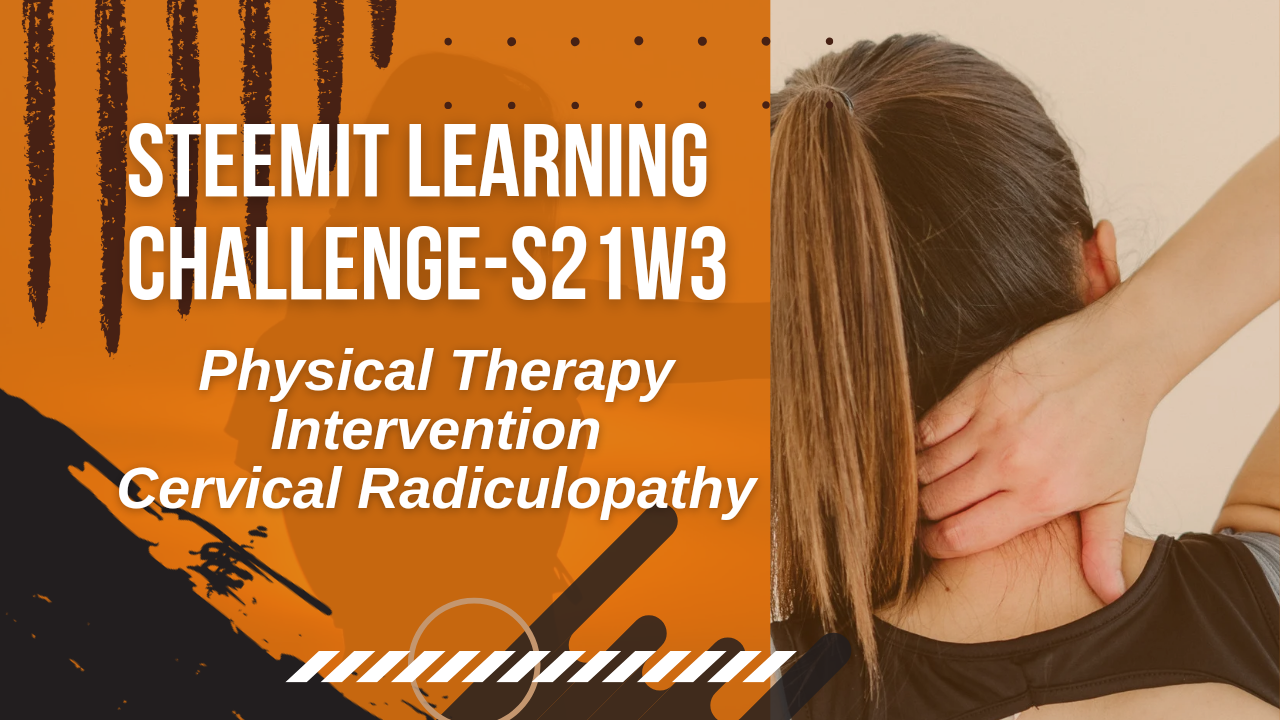Steemit Learning Challenge-S21W3; Cervical Radiculopathy"
2 comments
 |
|---|
I feel really happy to join in on this week's contest, I could not participate last week because of my rigorous activities but am super glad I could make that of this week. A special thanks to our dear professor @ashkhan who has been doing a very great work with these lesson. We really appreciate.Below is my entry into this contest and I really do hope I present to the best of my ability.
A cervical radiculopathy can be defined as a medical condition which is caused by an irritated nerve in the neck region of the body...when the root of a nerve is being pinched via a herniated disc or bone.
The nerve root makes movement or travels and when it does from the spinal cord it supplies sensations and signal but when these nerves are irritated or pinched, there would definitely be a problem which can result into muscle weakness, numbness and ultimately pain in the areas the nerve travels to. Let's take a deeper look into the cause of cervical radiculopathy. The first being...
• Herniated disc: this is as a result from pressure placed on the disc or vertebrate when the neck is bent forward,backward or twisted to the left or right and this can be painful when the vertebrate or disc can no longer hold the pressure form the rigorous movement of the neck. This pain is what we refer to as herniated disc. It's also important to mention that this particular medical condition is common among middle aged folks.
 |
|---|
• Degeneration and bone spur: this can also result in the medical cervical radiculopathy condition we are dealing with. As man gets older, degenerative disc disease is something that can cause a very serious problem because like bone spur which hides around the nerve roots just inside the foramen.
Now when bone spur grow to become so big they begin to interfere and rub on the nerve root which then result into irritation and pain
Other cause for this cervical radiculopathy condition include the following...
a.Osteoarthritic changes, b.Spondylosis,
c.Biochemically induce
d. Radiculopathy,
e.Trauma
d.Tumor.
Diagnosing cervical radiculopathy is a very sensitive task that requires a lot of expertise, however I have some steps that you can find useful. Below are the steps a typical medical practitioner would love to take.
• Complete Medical condition History: before the medical practitioner decide to do anything at all, he first of all understand the nature of the problem you're going through by gathering as much information as he can to aid him in his assessment. He does this by asking questions orally or giving you a form where you fill in some of the answers he needs to help you. Examples of those questions include..
a. When was the first time you noticed the pain?
b. Did you start or increase your normal routine or level of activities?
c. Do you have any record of past injury or surgery in your neck region?
d. What direction does your pain go to, your arms or legs?
e. What activities do you do that increases or reduces the neck pain?
• Physical Examination:Answer to this question and many others he deems fit would help him know how best to help you out of that medical condition.
The information supplied by the patient will then be utilized by the doctor who then gives you some physical exercise to help ascertain what you've shared so far. The goal of the physical exercise is to check some of the following.
a. How well you're able to twist your neck and bend them
b. if there is muscle spasm around your neck region
c. Checking to see if there is numbness, irritation etc.
• X-rays: After carrying out all the physical things to be done, we need to look more within just to be sure there are no serious complications from within. With X-rays you can see through the body of anyone. The X-ray would be used on the neck region. The good thing is that X-ray can show both herniated and degenerated disc in that region
• MRI: This means Magnetic Resonance Imaging. It's a more deeper examination when compared to X-rays because of it ability to go beyond showing bones to showing nerves and disc. It can also discover tumors and other tissue disorders. It's also important to mention that MRI uses magnetic fields and radio waves to cross examine the neck region for better diagnosis.
I decided to practice three of the exercise that was shared in the lesson. They are part the physical therapy one can practice to fix these pain we are talking about. The three are as seen below.
• Isometric Neck Extension: This is practiced to improve neck extension. The reason is not far fetched, people suffering from Cervical Radiculopathy tend to have difficulty extending their necks, hence the reason for this exercise.
• Isometrics Neck Retraction:This exercise requires that you use your arm muscle coupled with the muscle on the neck just as seen in the video. The result is that the pectoralis major muscle is stretched to bring relief even as our arms are placed behind our necks to achieve this.
• Isometric Cervical Rotation:This exercise is to ensure rotation in the neck especially when there is severe pain to move the neck. Doing this gradually frees the affected muscle. It can be done on both direction, that is the right and the left side.
The exercise seem good to me, I felt my body stretching beyond the normal and bringing relief. Personally, I think I am going to take these particular ones serious because I seem to be experiencing a little back pain which slightly connects to the neck region. So I will be doing this more often to get a better result. Thanks for sharing this week's lecture dear professor. We I think I would love to drop my pen at this juncture and just before I go, I would love to invite @m-fdo @rakiya @radleking.
Regards
@lhorgic❤️
Comments